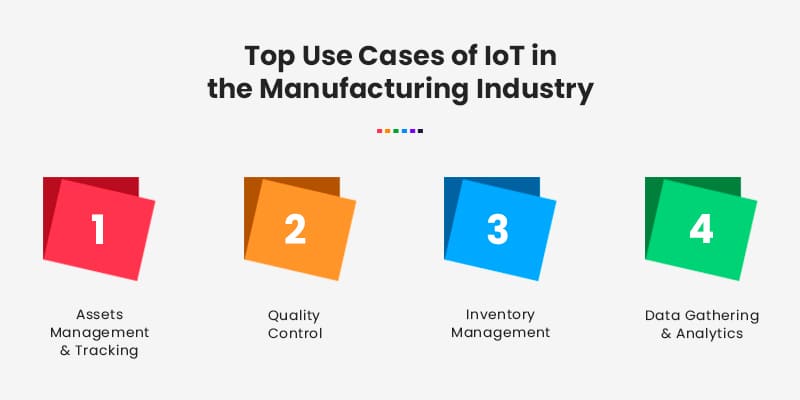
The IoT has been a gradually rising tide of transformation, and no industry has seen more of it than manufacturing. It’s no surprise that manufacturing has embraced IoT technologies. When the industry was getting accustomed to shifting economic conditions and reconstructing slow straight supply networks, the Internet of Things gave businesses the tools they needed to change.
Today, many manufacturing companies are investing heavily in IoT to improve business effectiveness by increasing capabilities. Already, manufacturing companies are using real-time information and predictive analytics to outperform their competitors in terms of market share and sales growth. According to the research, the global market size of the IoT in manufacturing was valued at $50 billion in 2021. This value is estimated to grow by $87.9 billion by 2026 at a CAGR of 11.9%. (SOURCE)
Therefore, in this blog, we’ll look at the various aspects showcasing how is IoT used in manufacturing and how it’s transforming the manufacturing landscape.
What is IoT?
The IoT is a network of networked objects or machines that can transmit and receive files over the network without or with very little human participation. As a result of this system, important actions on machinery can be taken on time, making them more efficient, safe, and practical to operate.
Today, many sectors all over the world have already used this technology, including the manufacturing industry!
But,
What is IoT in Manufacturing?
IoT (Internet of Things) in manufacturing refers to the integration of IoT devices and sensors into the manufacturing process to increase efficiency, productivity, and quality control. This can include using sensors to monitor machinery and equipment performance, track inventory levels, and gather data on production processes to improve decision making. IoT allows for asset management in manufacturing plants. It improves machine efficiency, lowers machine outage via IoT predictive maintenance, and helps with warehouse inventory management.
What is the Need of IoT in Manufacturing Industry?
There are numerous difficulties in the manufacturing industry like lack of availability and inefficiencies of available resources, delay or average duration to develop new products, and inability to satisfy consumer needs. Despite all efforts done are some of primary issues that industries confront throughout supply chain and operations. But all these issues have found solutions with Internet of Things. There are various benefits of IoT in manufacturing which we will be taking about soon. Here to give you glance let us tell you that it also ensures:
- Transform data into actionable insights for great business decisions
- Ensure that cooperation is efficient and safe
- Make effective use of predictive analytics
- Real-time data monitoring and management
- Make use of assets and equipment that are smart and linked
As manufacturers figure out how to deal with digitalization, the IoT market is growing fast. According to a PwC survey, 90 percent of manufacturers feel that modernizing the manufacturing process will provide more long-term benefits than difficulties.
Benefits of IoT in Manufacturing Industry
What benefits do manufacturers get from implementing IoT into their systems and activities? We’ve mentioned some of the advantages of IoT in the manufacturing industry below! So, take a look!
Predictive Maintenance
Maintenance is a difficult process, but with an IoT-enabled service termed Predictive Maintenance, it will be a lot easier.
Predictive Maintenance is a technique in which rotating machines are tracked using sensors, and the permission’s functional capacity is displayed on a cloud platform. All of this is possible by the IoT’s growth. Operation managers may immediately access current equipment status, notice warning signals, receive alerts of issues, and avoid spending time scheduling maintenance by accessing real-time data from sensors and devices.
The ability to obtain timely real-time useful information will enable managers to determine which equipment requires maintenance, allowing for better routine maintenance. It all adds up to more overall system availability.
Mitigate Risk
With even more efficient communication between IoT devices, manual procedures and activities are reduced to a far lower level. As you integrate IoT devices into the various areas of the business operations, menial work and the resulting human mistake are reduced to a considerable extent.
Better User Experience
How is IoT used in manufacturing, you ask? Well, it provides manufacturers with the opportunity to improve customer experience via real-time data collecting and analysis and enhance operational efficiencies. For instance, if a manufacturer understands how people use their product in the physical world, they may offer customers messages with tips on how to improve their experience. Furthermore, they may use the same information to help shape the improvements that will be shown in future models.
Increased Efficiency
The automated machinery can operate at a higher level of efficiency. When compared to conventional manufacturing, more precise production techniques can simplify a manufacturing unit’s operations. The Internet of Things makes operational insights and performance analysis more straightforward. From production to sales, data-driven decision-making, automation of manual processes and procedures, and continuous performance assessment enable a more efficient system.
Enhanced Data Security
Human inaccuracy is a big security problem for businesses regarding data management. With IoT in manufacturing manufacturers may digitize data management to a more significant extent. It can help in reducing the number of times human users must manually input or transfer data. As IoT enables remote access, IoT devices can transmit reports automatically, eliminating the need for error-prone email methods. Ultimately, this automation decreases the number of user input.
Lowers Downtime
When machines stop functioning or start underperforming, factories are frequently pressed to respond, forcing owners to expedite repairs and try to get output back up to full efficiency. Engineers would often interrupt industrial operations or work overtime to troubleshoot and rectify mechanical faults. Businesses are also confronted with unanticipated costs, delayed production plans, and missed deadlines if critical supplies are not in stock. Businesses may use the Internet of Things to better manage their operations and receive information about expected productivity and potential downtime. Additionally, IoT can source parts in advance of a machine’s downtime and routine schedule maintenance to avoid lost production.
Ensures Safety
With a mix of unique technologies, the IoT application in manufacturing can also improve workplace safety.
Smart factories with large-scale deployments of IoT-enabled smart sensors will provide continuous feedback on the status of the production floor. If an accident happens, the entire plant can be notified of potential hazards, with machinery being shut down and maintenance personnel being summoned to reduce the chance of worker injury.
Employees can also benefit from IoT wearables. A smart bracelet with built-in sound intensity sensors, for example, may alert the wearer to extremely noisy situations that could harm their hearing. Also, employees wearing augmented reality glasses, on the other hand, can see hazardous places and mishaps.
Cut Unnecessary Expenditure
It’s tough to break down and analyze how much power each piece of equipment takes over a given period of time because most managers maintain track of power consumption through monthly invoices. Manufacturing organizations may get comprehensive information on energy use for all equipment engaged in production using IoT power monitoring and management solutions. You will be capable of choosing from various options for optimizing equipment efficiency and lowering power consumption.
As you’ve seen the benefits of IoT in the manufacturing industry; now, let’s move forward and discuss,
Top IoT Use Cases in Manufacturing Industry

The digital era has increased customization and set higher expectations from the customer’s end. The manufacturers face several challenges to stand as per the consumer’s expectations. The Internet of Things has helped the manufacturing industry to take the lead in this new era by connecting consumers, manufacturers, and products. It is a global technology that is used to transform the manufacturing industry, and here we have presented you with a few useful use cases or IoT Application in Manufacturing and they are:
Assets Management & Tracking
Asset Management, or merely monitoring kinds of equipment for enhanced productivity and quality control, and worker safety, is made possible by IoT technology. The purpose of asset monitoring is for an organization to be able to quickly discover and monitor essential assets, such as those in the supply chain, in order to improve logistics, manage inventory levels, prevent quality concerns, and identify fraud.
Quality Control
The Internet of Things can monitor and control research and development at every level, including materials, temperature and production environment, and the volume of trash generated per product, among other things. The production manager will receive thorough reports on each phase of the product design process and the shipping and distribution of finished goods.
All of this information enables managers to perform in-depth quality control, optimize workflow, the surroundings, equipment quality, and transporting vehicle efficiency.
Inventory Management
With IoT development services in the manufacturing industry, factory managers will be able to track all of the supplies required for manufacture. This way, inventories can be renewed without putting the production process on stop. Effective inventory management will improve as quickly as the Internet of Things is installed since you will indeed be able to estimate how long it would take for a specific number of resources to burn out, improving long-term planning accuracy.
Data Gathering & Analytics
Manufacturers can turn data from remote production systems and assets into meaningful applications by gathering and contextualizing it. This enables businesses to acquire insights into important performance metrics, allowing them to identify problems faster and improve operational performance. Manufacturers can also manage production units remotely using connected devices as they have real-time data visibility across various manufacturing platforms.
IoT Trends in Manufacturing
The trends within the Internet of Things and RPA in manufacturing are adding advancements and innovations in the use of IoT technology. These trends aim to improve efficiency, productivity, and quality while reducing costs and increasing profitability. The IoT and RPA trends are driving significant changes in the manufacturing industry and providing companies with new opportunities to improve their operations and gain a competitive advantage.
Some of the key IoT trends in manufacturing include:
Edge Computing
This trend within IoT in manufacturing refers to processing data at the edge of the network, closer to the source of data, rather than in a centralized data center. This is important in the manufacturing industry because it allows data to be processed faster and more efficiently, reducing latency and improving responsiveness.
Integration with AI
This is a growing trend aimed at improving efficiency, quality, and decision-making in the manufacturing process. AI algorithms can be used to optimize supply chain management, reduce costs, and improve efficiency and responsiveness. With the integration of AI algorithms monitoring product quality in real-time, reducing defects and improving customer satisfaction is possible.
Industrial 5G
This IoT trend in manufacturing includes adopting 5G technology to provide faster and more reliable connectivity for IoT devices and sensors in the manufacturing environment.5G technology provides:
- Low latency
- Reducing the time, it takes for data to be transmitted and processed.
- Improving real-time monitoring and decision-making.
It can also provide enhanced security, reducing the risk of cyber-attacks and protecting sensitive data and information.
Augmented Reality (AR)
With this trend, the manufacturing industry can involve the use of AR technology to enhance the manufacturing process. AR technology overlays digital information onto the physical environment, providing real-time information and guidance to operators. The AR technology can facilitate collaboration between remote teams, improving communication and reducing the need for physical meetings.
How can the Future of IoT in Manufacturing be Characterized?
There are multiple ways that showcase the vivid yet in-depth use of IoT in the manufacturing industry. Here we have mentioned a few of the major aspects that can show the bright future offered by the Internet of Things to the manufacturers, and they are:
Smart Factories
IoT technology will enable the development of smart factories, where all aspects of production are connected and automated, from supply chain management to quality control.
Interoperability and Integration
With the IoT in the manufacturing industry, devices, and systems will become more interoperable. It will be integrated with other technologies, such as AI, AR/VR, and blockchain, to create new opportunities for innovation.
Increased Automation
The upgraded technologies of the Internet of Things will continue to drive automation and provide new opportunities for manufacturing companies. It will help them to increase efficiency, reduce costs, and improve productivity.
Predictive Maintenance
The future of IoT in Manufacturing will offer a widespread version of predictive maintenance as IoT devices and sensors become more widely adopted. This will allow manufacturers to address equipment issues and minimize downtime proactively.
Conclusion
It will be right to say that, the scope of IoT in manufacturing is constantly expanding, and companies that adopt IoT technology are well positioned to gain a competitive advantage and improve overall performance. Manufacturers boost user experience by using IoT to optimize the production process, which results in improved accessibility, higher-quality products, and the fastest delivery times.
Manufacturers may gain a competitive advantage by providing a higher level of product and service with IoT-enabled solutions. These advantages not only lower expenses and open up new revenue streams for businesses but also improve overall user contentment.
It allows for asset management in manufacturing plants, which improves machine efficiency, lowers machine outage via predictive maintenance, and helps with custom inventory management software. All of these advantages not only lower expenses and open up new revenue streams for businesses but also improve overall user contentment.
As a result, both manufacturers and consumers benefit, leading us to believe that IoT is the game-changer for the manufacturing industry. As a result, both manufacturers and consumers benefit, leading us to believe that IoT is the game-changer for the manufacturing industry. So, if you’re looking forward to IoT implementation and seeking the best IoT developers, contact us.




